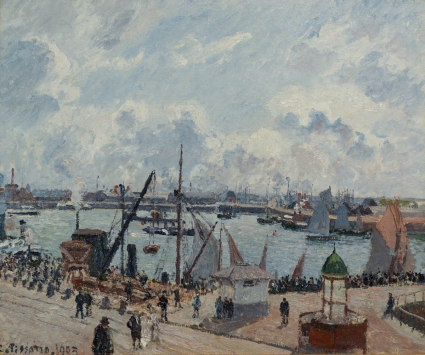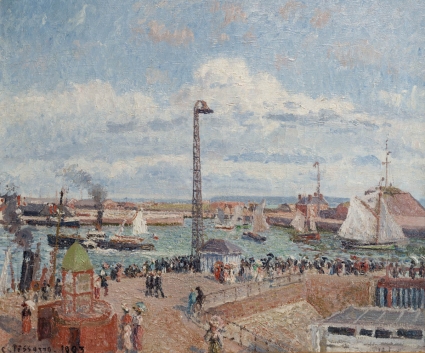Pissarro, The Pilots' Jetty and The Outer Harbour of Le Havre

Camille PISSARRO (1831-1903)
The Outer Harbour of Le Havre, Morning, Sun, Rising Tide
1903
oil on canvas
54.5 x 65 cm
© MuMa Le Havre / David Fogel
The Outer Harbour of Le Havre, Morning, Sun, Rising Tide
1903
oil on canvas
54.5 x 65 cm
© MuMa Le Havre / David Fogel
HD image

Camille PISSARRO (1831-1903)
Pilots' Jetty
1903
oil on canvas
54.5 x 65.3 cm
© MuMa Le Havre / David Fogel
Pilots' Jetty
1903
oil on canvas
54.5 x 65.3 cm
© MuMa Le Havre / David Fogel
HD image
podcast
Painted in Le Havre, these are two of the final artworks executed by Camille Pissarro (1830–1903), a few months prior to his death. The artist returned to the harbour where he had arrived as a child from the island of St Thomas in the West Indies. Finding himself in a delicate financial position in the spring of 1903, Pissarro was forced to cater to the tastes of collectors. He accepted an invitation from the collector Pieter van de Velde, based in Le Havre, who wanted him to paint a series depicting the rapidly changing outer harbour. The artist settled into the Continental hotel, which afforded him a stunning view over the entrance to the harbour, and chose the jetty as his motif, for he felt that it was an area of Le Havre "of which the people of the town are proud".
Part of a set of around twenty canvases, the two paintings at MuMa are representative of the final phase of his work. A founding member of Impressionism, Pissarro was drawn in 1886 to the scientific theories of the Neo-Impressionists like Signac and Seurat. After an entire series of works in which he broke down colours into small juxtaposed dabs, using the pointillist technique, he returned in 1890 to his old manner of painting, but with renewed subjects. In addition to the rural motifs that characterized his previous works, he began producing city and harbour scenes. The paintings portraying harbour basin activity in Le Havre are similar to a prolific series on the bustling streets and quays of Paris, Rouen and Dieppe.
At Le Havre, as with most of the works from this period, Pissarro adopted an elevated point of view, a high vantage point that had the advantage of protecting his fragile eyes from the dust that tended to irritate them. Between July and September 1903, he was able to paint three different series of the outer harbour from his window. While the motif of the information pillar appears in both MuMa paintings, one reveals to the east a section of the Grand Quai furrowed by tramway tracks, while the other, facing west, shows part of the old jetty with the pilot station in the foreground. All of the paintings in the series are variations on these two points of view, shifted more toward either the city or the water.
The composition of the two paintings is strongly structured by the slanted lines of the edges of the basins and the vertical lines of the streetlamps, masts and ship funnels. With these electrical installations, cranes and steamers, Pissarro gives us a decidedly modern view of the harbour of Le Havre. He captures the onlookers in full motion giving the scene the feel of a snapshot. The motifs, bluntly cut by the edges of the painting, also call to mind the photographic images that fascinated so many painters at the time.
On August 29, 1903, when Pissarro expressed to his son Lucien his disappointment in the art collectors of Le Havre who were "still concerned with Salon painting", he must have ignored the fact that Olivier Senn had acquired two of his works in 1900, and that the collectors Van der Velde, Dussueil and Metz had each purchased a canvas from the series. Although the artist berated the ignorance of the museum's purchasing commission, this was the first transaction he negotiated directly with such an institution. Pissarro nevertheless acknowledged the beginnings of a change. With this double acquisition, the city of Le Havre became the first French municipality to enrich the collection of its museum with the works of Pissarro.
Part of a set of around twenty canvases, the two paintings at MuMa are representative of the final phase of his work. A founding member of Impressionism, Pissarro was drawn in 1886 to the scientific theories of the Neo-Impressionists like Signac and Seurat. After an entire series of works in which he broke down colours into small juxtaposed dabs, using the pointillist technique, he returned in 1890 to his old manner of painting, but with renewed subjects. In addition to the rural motifs that characterized his previous works, he began producing city and harbour scenes. The paintings portraying harbour basin activity in Le Havre are similar to a prolific series on the bustling streets and quays of Paris, Rouen and Dieppe.
At Le Havre, as with most of the works from this period, Pissarro adopted an elevated point of view, a high vantage point that had the advantage of protecting his fragile eyes from the dust that tended to irritate them. Between July and September 1903, he was able to paint three different series of the outer harbour from his window. While the motif of the information pillar appears in both MuMa paintings, one reveals to the east a section of the Grand Quai furrowed by tramway tracks, while the other, facing west, shows part of the old jetty with the pilot station in the foreground. All of the paintings in the series are variations on these two points of view, shifted more toward either the city or the water.
The composition of the two paintings is strongly structured by the slanted lines of the edges of the basins and the vertical lines of the streetlamps, masts and ship funnels. With these electrical installations, cranes and steamers, Pissarro gives us a decidedly modern view of the harbour of Le Havre. He captures the onlookers in full motion giving the scene the feel of a snapshot. The motifs, bluntly cut by the edges of the painting, also call to mind the photographic images that fascinated so many painters at the time.
On August 29, 1903, when Pissarro expressed to his son Lucien his disappointment in the art collectors of Le Havre who were "still concerned with Salon painting", he must have ignored the fact that Olivier Senn had acquired two of his works in 1900, and that the collectors Van der Velde, Dussueil and Metz had each purchased a canvas from the series. Although the artist berated the ignorance of the museum's purchasing commission, this was the first transaction he negotiated directly with such an institution. Pissarro nevertheless acknowledged the beginnings of a change. With this double acquisition, the city of Le Havre became the first French municipality to enrich the collection of its museum with the works of Pissarro.
























